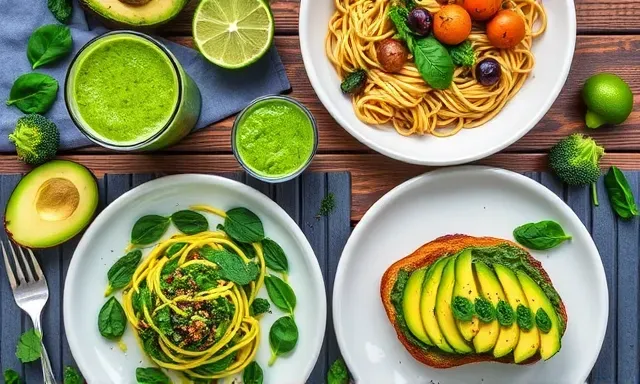Understanding Small Habits for Big Health Changes
"By Omar Fadil"
Have you ever wondered how small changes in your daily habits could significantly improve your health? The idea of overhauling your lifestyle can feel overwhelming, but what if the secret to better health lies in simple, manageable steps? By focusing on small, consistent actions—like adding greens to your meals or making mindful food swaps—you can transform your well-being without sacrificing your favorite flavors or breaking the bank.
 |
| Small Habits for Big Health Changes |
1 Adding Greens to Every Meal
Have you ever felt that your meals are missing a certain “something” when it comes to nutrition? Adding greens to your plate is one of the simplest and most effective ways to boost your health without overhauling your entire diet. Greens like spinach, kale, arugula, and broccoli are nutritional powerhouses, packed with vitamins, minerals, and fiber. But how can you seamlessly incorporate them into every meal without feeling like you're eating the same thing every day?
Why Greens Matter
Leafy greens are not just low in calories; they’re also brimming with nutrients like:
- Vitamin K: Supports bone health and aids in blood clotting.
- Iron: Crucial for oxygen transport in the blood, preventing fatigue.
- Antioxidants: Combat free radicals and reduce inflammation in the body.
By adding greens to every meal, you’re giving your body a steady supply of these essential nutrients, helping to improve digestion, boost energy, and support overall health.
Easy Ways to Incorporate Greens
Here are some practical tips to sneak greens into your meals:
Breakfast:
- Add a handful of spinach to your morning smoothie for a nutrient boost without altering the flavor.
- Toss kale into scrambled eggs or an omelet.
- Use avocado toast as a base and layer it with arugula or microgreens.
Lunch:
- Mix greens like romaine or mixed salad leaves into your sandwiches or wraps.
- Blend greens into soups for added fiber and richness.
- Choose a grain bowl and load it up with sautéed or fresh spinach.
Dinner:
- Incorporate chopped greens into pasta dishes, such as adding spinach to spaghetti or lasagna.
- Use greens as a pizza topping for extra crunch and flavor.
- Stir-fry vegetables with bok choy or mustard greens as a flavorful side dish.
Overcoming Common Barriers
Worried that greens will taste bitter or overpower your meals? Try these tips:
- Balance Flavors: Pair greens with sweet fruits like apples or berries in salads to balance bitterness.
- Experiment with Cooking Methods: Steaming or sautéing can mellow the flavor and make it more palatable.
- Start Small: Incorporate a little at a time—like adding spinach to your favorite recipes—to ease into the habit.
2 Small Food Swaps for Healthier Eating
Do you ever feel like eating healthier means giving up all your favorite foods? The good news is it doesn’t have to! Small, thoughtful food swaps can help you enjoy the flavors you love while making healthier choices. These swaps are easy to incorporate into your daily routine and can make a big difference over time.
Why Small Swaps Work
Changing your eating habits doesn’t have to be drastic. By substituting certain ingredients or products with healthier alternatives, you can:
- Lower your calorie intake.
- Improve your nutrient profile.
- Reduce unhealthy fats and added sugars.
Small changes are also more sustainable, making it easier to stick to a healthier lifestyle without feeling deprived.
Simple and Effective Food Swaps
Here are some practical swaps to try:
 |
| Small Habits for Big Health Changes |
Baking and Cooking:
- Swap butter or oil with unsweetened applesauce or mashed bananas in baked goods.
- Use Greek yogurt instead of sour cream for dips and dressings—it’s creamy and packed with protein.
- Choose whole-grain or legume-based pasta instead of refined white pasta for added fiber and nutrients.
Snacks and Sweets:
- Replace potato chips with air-popped popcorn or roasted chickpeas for a crunchy and satisfying snack.
- Satisfy your sweet tooth with fresh fruit, dark chocolate, or yogurt parfaits instead of candy or sugary desserts.
- Try rice cakes or whole-grain crackers topped with almond butter instead of processed snack bars.
Drinks:
- Swap sugary sodas for sparkling water with a splash of fresh fruit juice or herbal tea.
- Replace high-calorie coffee creamers with unsweetened almond milk or oat milk.
- Cut back on sugar in your coffee or tea by gradually reducing the amount over time.
Benefits Beyond the Plate
These small swaps do more than improve your meals—they also:
- Support weight management by reducing calorie-dense ingredients.
- Lower your risk of chronic diseases like heart disease and diabetes.
- Provide long-lasting energy with nutrient-rich options.
Making It a Habit
Wondering how to make these swaps part of your routine? Here are some tips:
- Plan Ahead: Keep healthier alternatives stocked in your pantry or fridge.
- Experiment: Try one new swap each week to find what works for you.
- Stay Flexible: Don’t aim for perfection; even small changes count!
3 Gradual Sugar Reduction Tips
Have you ever thought about how much sugar sneaks into your daily diet? From morning coffee to evening snacks, sugar can quietly add up, impacting your energy levels, weight, and overall health. Cutting back on sugar doesn’t mean giving up sweetness altogether—it’s about making mindful choices that help you feel your best.
Why Reducing Sugar Matters
Excessive sugar consumption has been linked to a variety of health concerns, including:
- Increased risk of obesity and diabetes.
- Tooth decay and oral health problems.
- Energy crashes and mood swings.
Gradually reducing your sugar intake can help stabilize your energy, improve your focus, and support long-term health.
Practical Tips for Gradual Sugar Reduction
Start with Beverages:
- Switch sugary sodas and energy drinks for unsweetened herbal teas or sparkling water with a splash of lime.
- Reduce sugar in coffee or tea by half and use a natural sweetener like stevia if needed.
- Opt for homemade fruit-infused water instead of store-bought juices.
Rethink Snacks:
- Choose whole fruits over fruit-flavored snacks or candy for natural sweetness and added fiber.
- Replace sugary granola bars with nuts, seeds, or unsweetened trail mixes.
- Swap ice cream with frozen yogurt or banana-based "ice cream."
Check Labels:
- Learn to spot hidden sugars in ingredient lists—look for words like "fructose," "sucrose," or "high-fructose corn syrup."
- Choose products labeled "unsweetened" or "no added sugar" whenever possible.
- Be mindful of condiments like ketchup and salad dressings, which often contain surprising amounts of sugar.
Bake Smart:
- Cut sugar in recipes by 25-50%—you’ll often find it doesn’t impact taste as much as you’d think.
- Experiment with natural sweeteners like honey, maple syrup, or mashed dates.
- Add flavor with spices like cinnamon or vanilla extract instead of relying solely on sugar.
Making It Stick
Here are strategies to ensure your sugar reduction journey is sustainable:
- Take It Slow: Gradual changes are easier to adapt to and maintain.
- Celebrate Wins: Notice how your taste buds adjust and celebrate small victories, like enjoying less sugary treats.
- Stay Flexible: It’s okay to indulge occasionally—balance is key!
4 Weekly Food Challenges for Families
Looking for a fun and engaging way to inspire healthier eating habits for your family? Weekly food challenges can be a creative way to introduce new ingredients, try healthier options, and make mealtime more exciting. These challenges aren’t just about food—they’re a chance to bond, learn, and develop habits that benefit everyone.
Why Food Challenges Work
- Interactive Learning: Kids and adults alike learn about nutrition in a hands-on way.
- Encourages Variety: Introducing new foods can prevent picky eating and improve your family’s nutrient intake.
- Creates Healthy Habits: Fun challenges encourage sustainable changes without feeling like a chore.
Fun Weekly Challenges to Try
“Add a Veggie” Challenge:
- Goal: Add a new vegetable to one meal every day for a week.
- How to do it:
- Try roasted Brussels sprouts, spiralized zucchini noodles, or colorful bell peppers.
- Let kids choose a vegetable to feature—they’re more likely to eat what they help pick.
- Benefits: Boosts fiber, vitamins, and minerals in your meals.
“No-Sugar Snacks” Challenge:
- Goal: Replace sugary snacks with healthier alternatives for one week.
- Ideas to try:
- Apple slices with almond butter.
- Homemade energy balls made with oats and dates.
- Air-popped popcorn with a sprinkle of nutritional yeast.
- Benefits: Reduces sugar intake while keeping snacks fun and delicious.
“DIY Dinner” Challenge:
- Goal: Make one homemade meal together as a family every night.
- How to make it fun:
- Assign everyone a role, from chopping to plating.
- Experiment with simple, healthy recipes like veggie-packed stir-fry or build-your-own taco bowls.
- Benefits: Teaches cooking skills and promotes teamwork.
“Hydration Heroes” Challenge:
- Goal: Drink a specific amount of water daily, with fun trackers or stickers for kids.
- Make it exciting:
- Add lemon, cucumber, or berries to infuse water with flavor.
- Use colorful reusable bottles to make staying hydrated a treat.
- Benefits: Improves focus, energy, and overall health.
“Budget-Friendly Meal Planning” Challenge:
- Goal: Plan a week’s worth of healthy meals on a tight budget.
- Tips for success:
- Shop sales and use seasonal produce.
- Batch-cook and freeze meals to save time and money.
- Choose cost-effective ingredients like beans, lentils, and whole grains.
- Benefits: Shows that eating well doesn’t have to break the bank.
Building Connection Through Challenges
The beauty of weekly food challenges is that they go beyond nutrition—they foster creativity, teamwork, and connection. Each challenge is an opportunity to celebrate small victories and encourage one another.
 |
| Small Habits for Big Health Changes |
As you take on these weekly challenges, you’re not just improving your family’s health—you’re creating a lifetime of shared memories and habits. Which challenge will your family try first?
5 Healthy Eating on a Tight Budget
Eating healthy doesn’t have to cost a fortune. In fact, with a little creativity and planning, you can enjoy nutritious, delicious meals without overspending. Whether you’re cooking for one or feeding a family, these tips and tricks will help you make the most of your food budget while prioritizing your health.
Why Budget-Friendly Healthy Eating Matters
- Accessible Nutrition: Healthy food should be attainable for everyone, regardless of financial constraints.
- Reduces Waste: Planning ahead ensures that you use what you buy, saving money and resources.
- Sets a Positive Example: Demonstrates to kids and loved ones that eating well is possible, no matter the budget.
Smart Strategies for Budget-Friendly Healthy Eating
Plan Your Meals:
- Make a Weekly Menu: Outline meals for the week, focusing on affordable, healthy options.
- Create a Shopping List: Stick to your list to avoid impulse purchases.
- Batch Cooking: Prepare meals like soups, stews, or casseroles that can be reheated throughout the week.
Shop Wisely:
- Choose Seasonal Produce: Fruits and vegetables are often cheaper and fresher when they’re in season.
- Buy in Bulk: Items like rice, beans, and oats are cost-effective when purchased in larger quantities.
- Opt for Frozen or Canned: Frozen vegetables and canned beans are budget-friendly and just as nutritious. Look for options without added sugar or salt.
Cook at Home:
- Preparing meals from scratch is significantly cheaper than eating out or buying pre-packaged foods.
- Experiment with Simple Recipes: Start with basics like stir-fries, pasta dishes, or hearty salads.
- Use Leftovers Creatively: Turn last night’s dinner into a new meal, like a frittata or stir-fry.
Embrace Affordable Protein Sources:
- Beans and Lentils: Versatile and packed with nutrients, they’re excellent meat substitutes.
- Eggs: A budget-friendly protein that works for breakfast, lunch, or dinner.
- Canned Tuna or Chicken: Convenient and affordable options for salads or sandwiches.
Be Strategic About Snacks:
- Make your own snacks, like popcorn or trail mix, instead of buying expensive packaged items.
- Slice fresh veggies for dipping or prepare homemade hummus as a healthy alternative.
Bonus Tips to Maximize Your Savings
- Use Store Discounts and Coupons: Take advantage of sales and promotions to stock up on essentials.
- Cook Once, Eat Twice: Double recipes and freeze portions for future meals.
- Avoid Food Waste: Store leftovers properly and learn how to use every part of the ingredients you buy.
The Bigger Picture
Healthy eating on a tight budget isn’t just about saving money—it’s about empowerment. By making intentional choices, you’re prioritizing your health, improving your cooking skills, and setting a strong example for others.
 |
| Small Habits for Big Health Changes |
With a little planning and resourcefulness, you’ll find that eating well within your means is not only achievable but deeply satisfying. What budget-friendly meal will you try this week?
Conclusion: Small Steps, Big Health Rewards
Improving your health doesn’t have to involve drastic changes or expensive commitments. By focusing on small, sustainable habits like adding greens to your meals, making mindful food swaps, or gradually reducing sugar, you can create a lifestyle that feels both attainable and rewarding. The journey to better health begins with one small step, and every positive choice you make builds momentum for lasting change.
Remember, it’s not about perfection—it’s about progress. Maybe you’ll try incorporating a weekly food challenge with your family or explore creative ways to eat healthy on a tight budget. These small actions, repeated over time, can lead to big transformations in your energy, well-being, and overall quality of life.
So, what’s your next step? Whether it’s planning your meals more intentionally, experimenting with new recipes, or simply swapping one sugary treat for a healthier option, the key is to start. Celebrate your wins, no matter how small, and keep moving forward. After all, the path to better health is made of these tiny, meaningful choices that ultimately lead to a happier, healthier you.
 |
| Small Habits for Big Health Changes |
Are you ready to embrace the power of small habits for big health changes? Let’s take the first step together.
References:
Healthy Eating on a Budget - USDA MyPlate
The USDA's MyPlate offers practical tips for making healthy food choices within your budget.
MonAssiette
Healthy Food Swaps - NHS
The NHS provides a comprehensive guide on healthier food swaps to improve your diet.
nNHSuk
Healthy Eating on a Budget - Healthline
Healthline offers 19 ways to eat healthy on a tight budget, including tips on meal planning and shopping smart.
Healthline
Healthy Swaps for Common Foods - American Heart Association
The American Heart Association provides healthy swaps for common foods to help improve your diet.
American Heart Association
Healthy Food Swaps - Healthdirect
Healthdirect offers a guide on healthy food swaps to help you make nutritious choices.
Healthdirect
Healthy Food Swaps - Bupa
Bupa provides a list of 50 healthy food swaps to help you make better dietary choices.
Bupa
Healthy Food Swaps - BBC Good Food
BBC Good Food offers a guide on the top 10 healthy food swaps to improve your diet.
BBC Good Food
Healthy Food Swaps - Scripps Health
Scripps Health provides six simple food swaps for better health.
Scripps
Healthy Eating on a Budget - HelpGuide
HelpGuide offers tips for eating healthy on a budget, including meal planning and shopping strategies.
Help Guide
Healthy Eating on a Budget - Nutrition.gov
Nutrition.gov provides information on nutrition on a budget, including healthy meal and snack ideas.
FAQ
Small habits like drinking more water, walking daily, eating more vegetables, and maintaining a regular sleep schedule can significantly enhance overall health over time.
It typically takes about 21 to 66 days to form a new habit, depending on the individual and the complexity of the habit.
Small changes are sustainable and easier to implement, reducing the risk of overwhelm. Over time, these small changes accumulate, leading to significant improvements in health.
Yes, small habits such as regular physical activity, healthy eating, and stress management can significantly reduce the risk of chronic diseases like diabetes and heart disease.
Tracking progress, celebrating small wins, and focusing on the long-term benefits can help maintain motivation for small habits.






